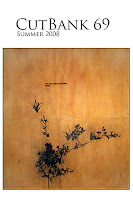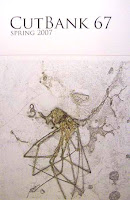
As real as thinking/wonders created/by the possibility—forms…
—Robert Creeley
No gap has ever appeared in the transmission of language
—Andrew Schelling
The edge isn’t far we could be there now
—G.E. Patterson
Ahsahta Press, 2008
Reviewed by Heather Sweeney
To and From, G.E. Patterson’s second collection, evokes deeply felt displacements and departures. Patterson charts out new terrain as he carefully tends to uncertainties in his fourteen-line constructions. Bringing temporality and its relationship to geography to the surface, the poet suggests that we are forever “stuck on the possibility of being.” Possibilities congregate and disperse, becoming the only constant within these pulsating territories.
In To and From, Patterson consistently subverts the traditional and most common modes of quoting lines, raising, as he does so, issues of attribution and ownership. Bits of quotes hover and billow above, between, and sometimes below many of his poems. Utterances echo as they unfold upon each other. Patterson is a technician of elision. Carefully selected words address and incite questions. In an interview with Lisa Stouder for Ahsahta Press, the poet himself asks and illuminates: “Who owns language? Who has phrased a thought or feeling in a way that might be seen as proprietary?”
Consider:
Consider:
“River smell….”
—Forrest Gander
Salvator Mundi
(tr. Edwin Honig)
“…streets….”
—Jean Cocteau
“…all sorts of things…” “River smell….”
—Henry James —Forrest Gander
“…which made it beautiful.”
—Brenda Hillman
—Forrest Gander
“…below us…above us…out of sight…"
—Ralph Waldo Emerson
Salvator Mundi
“…always….” “…deer….”
—Michael Ondaatje —Federico Garcia Lorca(tr. Edwin Honig)
“…streets….”
—Jean Cocteau
“…all sorts of things…” “River smell….”
—Henry James —Forrest Gander
“…which made it beautiful.”
—Brenda Hillman
(48)
Patterson re-means and reconfigures. The sampled amalgamation of voices includes cameos by Virginia Woolf, Robert Duncan and Yoko Ono. Summoning this eclectic group, he infuses their articulations with unique magnification, as his own images continue to morph: “Invisibility tree swan perhaps/This room seen with a bird’s anatomy (5)."
Quotations become titles and silences are attributed: “ '….' (unwritten words)/—John Milton.” The gathered tensions between what is said and unsaid, heard and unheard, texture his perceptions.
Between the silences, Patterson spotlights temporality in drifting landscapes that transform and evaporate. He has lived in and traveled to many states, and his poems follow a similar route, taking us from New York’s “factory of candles” to a North Carolina resort town to Cape Cod where “Mountainous abstractions might form and cloud/The ink-darkened trees then reshape themselves (64)." And we are forever in a liminal state, often seeking and contemplating stability: “coming from the car as it moves what stays (12)."
Acting as the observer, Patterson is lucid and seemingly detached: “Daytime moving in swirls the painted colors (16)." In his biography for Ahsahta Press, Patterson asserts: “Focus on the present moment. That’s the refrain from years of studying meditation and practicing yoga.” His yogic background comes as no surprise, as he plays with expansion and lets space breathe around the commingling voices. Expressions percolate and congeal. Fragmentation and genuine integration reveal themselves.
Often recording the rural and scenic, Patterson also illuminates very base human hungers: “Desires like horses persist and run (5)." He shuffles varying roads, voices, trees, and distances. Lines such as “The bigness scented the trees as expected (50)" heighten our inquiry about the capabilities of perception, because, as the observer points out, “In some sequence small things were going on (50)."
Patterson investigates what we hope to contain, what can be held and recorded. This is a contemplative book of distances shaping and reshaping the spaces between to and from. These poems “…wail at the ocean’s border (6)." These poems are tender, yet subtly electric, “pulling us closer (50)."
**
G.E. Patterson is the author of Tug (Graywolf Press, 1999), which won the Minnesota Book Award. His work has appeared in several magazines and anthologies, including Bum Rush the Page, Poetry 180, American Letters and Commentary, Fence, Five Fingers Review, nocturnes: (re)view of the arts, Seneca Review, Open City, XcP: Cross Cultural Poetics, and the webzine of the St. Mark's Poetry Project, Poems and Poets. He lives in Minnesota.
**
Heather Sweeney, who teaches writing and yoga, lives in San Diego with her husband and beloved dog.




